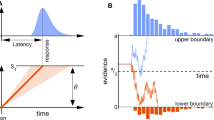Abstract
The modular visual system of jumping spiders (Salticidae) divides characteristics such as high spatial acuity and wide-field motion detection between different pairs of eyes. A large pair of telescope-like anterior-median (AM) eyes is supported by 2–3 pairs of ‘secondary’ eyes, which provide almost 360 degrees of visual coverage at lower resolution. The AM retinae are moveable and can be pointed at stimuli within their range of motion, but salticids have to turn to bring targets into this frontal zone in the first place. We describe how the front-facing pair of secondary eyes (anterior lateral, AL) mediates this through a series of whole-body ‘tracking saccades’ in response to computer-generated stimuli. We investigated the ‘response area’ of the AL eyes and show a clear correspondence between the physical margins of the retina and stimulus position at the onset of the first saccade. Saccade frequency is maximal at the margin of AL and AM fields of view. Furthermore, spiders markedly increase the velocity with which higher magnitude tracking saccades are carried out. This has the effect that the time during which vision is impaired due to motion blur is kept at an almost constant low level, even during saccades of large magnitude.




Similar content being viewed by others
References
Aptekar JW, Shoemaker PA, Frye MA (2012) Figure tracking by flies is supported by parallel visual streams. Curr Biol 22:1–6
Bahill A, Clark M, Stark L (1975) The main sequence, a tool for studying human eye movements. Math Biosci 24:191–204
Blest AD, O’Carroll DC, Carter M (1990) Comparative ultrastructure of Layer I receptor mosaics in principal eyes of jumping spiders: the evolution of regular arrays of light guides. Cell Tis Res 262:445–460
Duelli P (1978) Movement detection in the posterolateral eyes of jumping spiders (Evarcha arcuata, Salticidae). J Comp Physiol A 124:15–26
Eakin R, Brandenburger J (1971) Fine structure of eyes of jumping spiders. J Ultrastruct Res 37:618–663
Fenk LM, Schmid A (2010) The orientation-dependent visual spatial cut-off frequency in a spider. J Exp Biol 213:3111–3117
Fenk LM, Schmid A (2011) Flicker-induced eye movements and the behavioural temporal cut-off frequency in a nocturnal spider. J Exp Biol 214:3658–3663
Forster L (1979) Visual mechanisms of hunting behaviour in Trite planiceps, a jumping spider (Aranae: Salticidae). NZ J Zool 6:79–93
Harland D, Jackson RR (2000) “Eight-legged cats” and how they see–a review of recent research on jumping spiders (Araneae: Salticidae). Cimbebasia 16:231–240
Harland D, Jackson RR (2004) Portia Perceptions: the Umwelt of an araneophagic jumping spider. In: Prete FR (ed) Complex worlds from simpler nervous systems. MIT Press, Cambridge, pp 5–40
Harland D, Li D, Jackson RR (2012) How jumping spiders see the world. In: Lazareva OF, Shimizu T, Wasserman EA (eds) How animals see the world: comparative behavior, biology, and evolution of vision. Oxford University Press, New York, pp 133–164
Homann H (1928) Beiträge zur Physiologie der Spinnenaugen. J Comp Physiol A 7:201–268
Komiya M, Yamashita S, Tateda H (1988) Turning reactions to real and apparent motion stimuli in the posterolateral eyes of jumping spiders. J Comp Physiol A 163:585–592
Labhart T, Nilsson D (1995) The dorsal eye of the dragonfly Sympetrum: Specializations for prey detection against the blue sky. J Comp Physiol A 176:437–453
Land MF (1969a) Structure of the retinae of the principal eyes of jumping spiders (Salticidae: Dendryphantinae) in relation to visual optics. J Exp Biol 51:443–470
Land MF (1969b) Movements of the retinae of jumping spiders (Salticidae: Dendryphantinae) in response to visual stimuli. J Exp Biol 51:471–493
Land MF (1971) Orientation by jumping spiders in the absence of visual feedback. J Exp Biol 54:119–139
Land MF (1972) Stepping movements made by jumping spiders during turns mediated by the lateral eyes. J Exp Biol 57:15–40
Land MF (1985) Fields of view of the eyes of primitive jumping spiders. J Exp Biol 119:381–384
Laughlin SB, de Ruyter, van Steveninck RR, Anderson JC (1998) The metabolic cost of neural information. Nat Neurosci 1:36–41
Lea J, Mueller C (1977) Saccadic head movements in mantids. J Comp Physiol A 114:115–128
Maddison WP, Hedin MC (2003) Jumping spider phylogeny (Araneae:Salticidae). Invertebr Syst 17:529–549
Mittelstaedt H (1957) Prey capture in mantids. In: Scheer BT (ed) Recent advances in invertebrate physiology. University of Oregon Press, Eugene, pp 51–71
Nelson XJ, Jackson RR (2011a) Anti-Predator Behaviour. In: Herberstein ME (ed) Spider behaviour. Cambridge University Press, Cambridge, pp 51–73
Nelson XJ, Jackson RR (2011b) Foraging Behaviour. In: Herberstein ME (ed) Spider behaviour. Cambridge University Press, Cambridge, pp 5–30
Neuhofer D, Machan R, Schmid A (2009) Visual perception of motion in a hunting spider. J Exp Biol 212:2819–2823
O’Carroll DC (1989) An optical assessment of visual performance in the eyes of hunting spiders (Araneae:Labidognatha) Dissertation, The Flinders University of South Australia
Rossel S (1980) Foveal fixation and tracking in the praying mantis. J Comp Physiol A 139:307–331
Schmid A (1998) Different functions of different eye types in the spider Cupiennius salei. J Exp Biol 201:221–225
Williams D, McIntyre P (1980) The principal eyes of a jumping spider have a telephoto component. Nature 288:578–580
Yamashita S (1985) Photoreceptor cells in the spider eye: spectral sensitivity and efferent control. In: Barth FG (ed) Neurobiology of arachnids. Springer, New York/Heidelberg, pp 103–117
Zurek D, Taylor AJ, Evans CS, Nelson XJ (2010) The role of the anterior lateral eyes in the vision-based behaviour of jumping spiders. J Exp Biol 213:2372–2378
Acknowledgments
We thank María Castillo-Pando (animal care), Rowan McGinley (spider collection), Ben Fanson and Eirik Søvik (helpful discussions). This work was supported by an Australian Research Council Discovery Grant (DP0772517) to XJN and by a Macquarie University Research Excellence Scholarship (DBZ).
Author information
Authors and Affiliations
Corresponding author
Rights and permissions
About this article
Cite this article
Zurek, D.B., Nelson, X.J. Saccadic tracking of targets mediated by the anterior-lateral eyes of jumping spiders. J Comp Physiol A 198, 411–417 (2012). https://doi.org/10.1007/s00359-012-0719-0
Received:
Revised:
Accepted:
Published:
Issue Date:
DOI: https://doi.org/10.1007/s00359-012-0719-0




